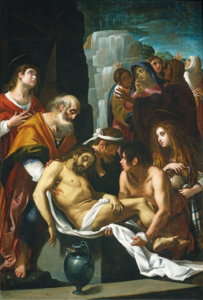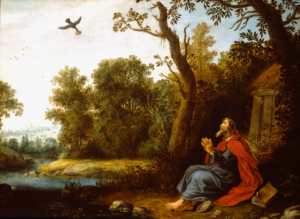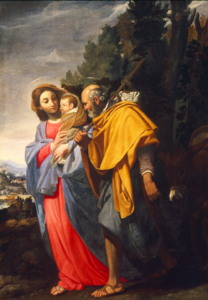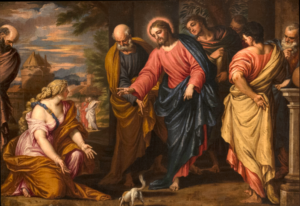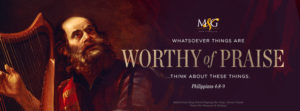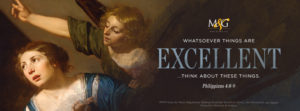The Body of Christ Prepared for Burial
Oil on canvas, signed and dated: .EQVS.IO.BAGLIONVS.RO.P.1616
Cavaliere Giovanni Baglione, called Il Sordo del Barozzo
Roman, c. 1566-1644
Giovanni Baglione was born, lived and died in Rome; although he received and completed art commissions elsewhere. He was an important artist in his day, even becoming President of the Roman Academy. He authored two books including The Lives of Painters, Sculptors, Architects and Engravers, active from 1572–1642, which has become a fundamental source for study of 17th-century Italian art of more than 200 artists, particularly in Rome.
Like many artists of the Baroque era, Baglione was influenced by the younger painter Michelangelo Merisi da Caravaggio. He sought to borrow and integrate Caravaggio’s naturalism and technique of dramatic light and shadow, which was quite novel. The two were in competition for commissions in Rome by the popes, nobles, and influentials.
Although incredibly talented, Caravaggio was arrogant and an angry, violent man. He expressed his hatred of Baglione through mockery and insults including his writing and circulating slanderous satirical poems criticizing him. In 1603, Baglione sued Caravaggio and three other painters (Orazio Gentileschi, Onorio Longhi, and Filippo Trisegni) for libel. According to the court records from the trial, Caravaggio said Baglione was no friend of his, and that he was not a good painter. Then he outlined his views in court about what a good painter was—“a man who can paint well and imitate nature well.” Essentially, in Caravaggio’s opinion, Baglione could do neither. In his book on the Lives, Baglione also shared his own view of Caravaggio saying, “he would speak badly of painters of the past, no matter how distinguished they were, because he thought that he alone had surpassed all other artists in his profession.”
Baglione’s most esteemed painting is in St. Peter’s Basilica in Rome, Peter Raising Tabitha from the Dead, for which he was made a Knight of the Order of Christ by Pope Paul V in 1606.
In spite of the bitterness between the two artists, Baglione produced a painting inspired by one of Caravaggio’s most renowned works—the Entombment in the Vatican Pinacoteca. If not the first, Baglione was one of the first artists to emulate Caravaggio’s revolutionary style, and he described his rival’s Entombment as Caravaggio’s best work. M&G’s The Body of Christ Prepared for Burial references some elements from Caravaggio’s work, such as the stone slab and highlighting and shadowing. M&G’s painting is not Baglione’s first version of the subject, which was finished in 1608—just five years after the libel lawsuit—as a commissioned altarpiece for the church of the Pio Monte della Misericordia in Naples.
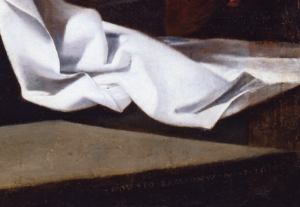 However, eight years later he refined the composition into M&G’s version, which he signed and dated the lower right corner of the stone slab as Cavaliere Giovanni Baglione, revealing his knightly status.
However, eight years later he refined the composition into M&G’s version, which he signed and dated the lower right corner of the stone slab as Cavaliere Giovanni Baglione, revealing his knightly status.
It’s ironic, but art historians believe that Baglione’s best pictures are his most “Caravaggesque.” M&G’s treatment is a more classical interpretation of Caravaggio’s version. We’re uncertain of who commissioned the canvas, but it may have been an altarpiece because of its size of more than 7’ tall, the centrality of Christ’s body, and the details with the elements of the passion (crown and nails on the lower left).
Among other specialists, Edgar Peters Bowron describes M&G’s painting as one of his “noblest compositions and demonstrates how good he was in his maturity.”
Today, Baglione is most famous for his authorship of two important books: a guidebook about Roman churches and the volume of artist biographies. He is also remembered for his interactions with Caravaggio. Yet, he was an extremely accomplished artist and favored by popes; he also proved that he was able to learn and profit from other more talented artists.
M&G’s painting is a rare example of Baglione’s work in America and one of his most significant paintings. Dr. Stephen Pepper has described it as “the most important painting by Baglione in an American collection.”
Erin R. Jones, M&G Executive Director
Published 2024
